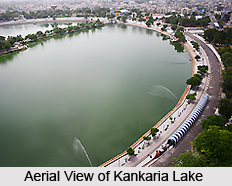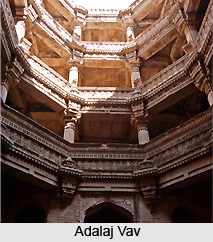 Ahmedabad, the city of Ahmed Shah is known for its rich past and each of the monuments and each corner of the historical relics still breaths the sigh of history. With a series of architectural wonder the city offers a lot to the visitor whilst catering to the varied mood of the visitor.
Ahmedabad, the city of Ahmed Shah is known for its rich past and each of the monuments and each corner of the historical relics still breaths the sigh of history. With a series of architectural wonder the city offers a lot to the visitor whilst catering to the varied mood of the visitor.
Ahmedabad does not therefore only possess city attractions; but has also a couple of tourists` spots outside the city`s perimeter, worth a visit.
Kankaria (3 km)
Another of Qutbuddin Ahmed Shah`s water enterprises, southeast of Ahmedabad, is the Kankaria Tank that was commenced in 1446. Although it is a 34-sided polygon, yet its proportions are vast enough for it to appear like a circle. Right in the centre is a garden island, attached to the shore by a walkway, called the Nagina Wadi. Just to the west of Kankaria, now known as the Hanging Gardens, are Dutch and Armenian tombs, dating back to 1615-1700. Obelisks, pyramids and pavilions distinguish these tombs and graves.
Asarva (6 km)
The Dada Hari Vav (step well), now dry, is an outstanding structure, seven-storeyed in depth. The pillars down the broad stairs have exquisite carvings. Built in 1501, it is an architectural wonder. Closeby is the mosque and tomb of Bai Harir. Inside the tomb, according to local faith, are the graves of the masons who had toiled to construct the well.
Adalaj (19 km)
Less than a kilometre off NH8C to Gandhi-nagar, is the Adalaj Vav, erected in 1501. It is even more vivid compared to the Dada Hari Vav. It has water, is deeper and better preserved. There is a chiseled motif of elephants, scuffling and pushing, but always united, going down the total length of the stairway. Entry is free fro everybody. The timings are from 9 a.m.- 6 p.m. It is open on all days. Still camera or free video can be done, with a payment of Rs 25.
Modhera (102km)
From Adalaj, one needs to travel by the state highway to Mahesana city, via Kalol, where one heads left for Modhera -the Sun Temple stands here, built in 1025 A.D. It is known for its ingenuity in design and implementation. Simply overwhelming is the bottomless, symmetrical stepped tank- the Surya Kund. Curiously enoough, the entire temple and the mandap appear to be defended on the spine of innumerable extravagantly sculpted elephants, ranged along the base.
 Entry fee for Indians is Rs 5, and foreigners Rs 100. Timings are from 9 a.m.- 5 p.m. It is open on all days. Still camera charges are incorporated within the fee. Video recording however needs to done with prior permission.
Entry fee for Indians is Rs 5, and foreigners Rs 100. Timings are from 9 a.m.- 5 p.m. It is open on all days. Still camera charges are incorporated within the fee. Video recording however needs to done with prior permission.
Vadnagar (108 km)
One can drive northeast of Mahesana to Vadnagar, via Visnagar. It is an ancient and scenic town, rested on the banks of crescent-shaped lake- the Sarmishta Talab. Also standing here is the ornately sculpted 16th century Hakteshwar Mahadev Temple. Closeby stands the `Kirti Toranas`, or ceremonial gateways, to the now non-existent 12th century temple. Constructed with red and yellow sandstone, without any mortar or cement, it is uncanny to witness these high toranas framing nothing but barrenness now.
Siddhpur (119 km)
One can continue north on the state highway from Mahesana city for another 50 km and one reaches Siddhpur via Unjha. Here one comes across rows and rows of palatial wooden 19th century townhouses. Painted in subdued pastel colours and built three-to-four storeys high, most of them were erected by the Bohras, Gujarat`s affluent mercantile Muslim community. Today, most of the houses remain locked for most part of the year and exhibit an oddly quiet and desolated European town look. But once a year (generally in December), the streets again pulsate with life, because the Bohra families return to Siddhpur for social ceremonies.
Also in Siddhpur are the unfathomable ruins of Rudra Mahalaya, the remains of a 12th century temple, with tantric connotations (additionally one can check out the sculpture on the outer walls). Photography is disallowed, but the place is unquestionably worth a visit.
Patan (133 km)
One must take a left turn from Unjha to reach the old city of Patan. Anhilvada Patan was the capital of the Solanki kings of Gujarat from 942-1304. The painstakingly sculpted 11th century Rani Ka Vav is doubtlessly the most exquisite of all Gujarat step-wells. The deeper one goes into the well, the greater sculptural detailing can be witnessed.
Sadly, almost nothing remains of the Sahastralinga Talao close by. Built by Siddharaj Jaya-simha (1094-1142), it is an impressive serpentine artificial lake (now dry) with elevated earthen embankments, stone ghats and the ruins of a Shiva temple.
Patan is also known for its patola sari weaving. The Salvis are the most illustrious weavers of Patan. One can ask for them around the chief bazaar and look for the distinguishable patola elephant design, accomplished in tile over the threshold, leading into their workshop.



















